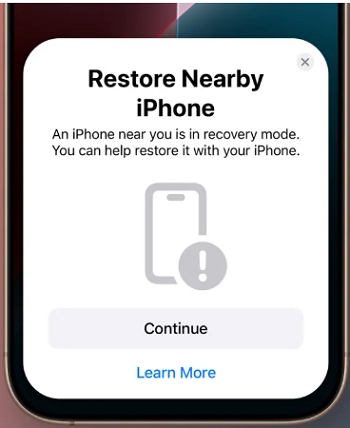Hot Topics
 by Maggie Mueller
Updated On Oct 23, 2024
Published On Oct 22, 2024
Basic iPhone Tips Ideal for Newbies
by Maggie Mueller
Updated On Oct 23, 2024
Published On Oct 22, 2024
Basic iPhone Tips Ideal for Newbies
The term "iPhone bricked" refers to an iPhone that has become completely unresponsive, effectively turning into an unusable "brick." This problem can manifest in a number of ways: your device may get stuck on the Apple logo, remain frozen on the lock screen, display a black screen, or simply refuse to power on.
Regardless of the symptoms, it is an incredibly frustrating issue for any iPhone user. In this article, we'll explore common causes for your iPhone to be bricked, and most importantly, actionable solutions to get your device back up and running.
There are several reasons why your iPhone or iPad may become bricked. The most common causes include:
If your iPhone is bricked, here are some of the most effective ways to fix it:
The first thing you should always try when your device is unresponsive is a force restart. If successful, it will at least allow you to regain access to your device so you can apply more advanced solutions later. The process to force restart varies depending on the model of your device:
For iPhone 8 and later (including iPads without a Home button):
Press and quickly release the Volume Up button, then press and quickly release the Volume Down button. Press and hold the Side button until the Apple logo appears on the screen.

For iPhone 7 and 7 Plus:
Press and hold the Volume Down and Power buttons simultaneously. Release both buttons when the Apple logo appears.

For iPhone 6s, iPhone SE, or iPads with a Home button:
Press and hold the Home and Power buttons simultaneously. Release both buttons when the Apple logo appears.

If a force restart doesn't work and the device remains unresponsive, we recommend trying TinyFix, an iOS system recovery tool specifically designed to resolve a variety of iOS system issues, such as iPhone is dead, iPhone keeping crashing, iPhone black screen, etc without losing data on your iPhone. TinyFix is highly effective, and you don't need technical expertise to use it. Simply follow these steps:
Step 1. Download and install TinyFix on your computer, then open the program.
Step 2. Select "iOS System Repair" and click "Standard Repair Mode" to begin.
Note: The Standard Repair option won't erase any data and settings on the device.

Step 3. Connect your bricked iPhone to the computer using a USB cable. If your device is not recognized by TinyFix, put your device in Recovery mode as the instructions.

Step 4. Once TinyFix detects the device, click "Download" to get the latest firmware for your iPhone.

Step 5. When the download is complete, click "Repair Now" and keep the device connected while the software repairs its system.

Once the repair process is complete, the iPhone will restart, and you can set it up.
Another way to fix a bricked device is by restoring it in recovery mode. This method requires you to connect your iPhone to a computer and use iTunes or Finder:
Step 1. Connect your iPhone/iPad to your computer.
Step 2. Follow these steps to put your iPhone in recovery mode:
For iPhone 8 or newer models:
Press and quickly release the Volume Up button, then the Volume Down button. Then press and hold the Side button until the recovery mode screen appears.

For iPhone 7 and 7 Plus:
Press and hold both the Volume Down and Side buttons until the recovery mode screen appears.

For iPhone 6s or earlier:
Press and hold the Home and Power buttons until the recovery mode screen appears.

Step 3. Finder or iTunes will detect your device:
Step 4. Click "Update" or "Restore", and keep your iPhone connected to the computer until the process is complete. Afterward, set up the device as new and restore your data from a backup.

If you have an iPhone 16 running iOS 18, it can be restored wirelessly from another device, according to 9to5Mac, similar to how you can restore an Apple Watch or Apple TV from an iPhone. Here's how:
When your iPhone is in recovery mode, place it next to another iPhone or iPad, and the second device will initiate firmware recovery. This device will download new iOS firmware and wirelessly transfer it to the bricked iPhone, without the need to connect it to a computer.
Note: This method only works for iPhone 16 models at the moment.

Device Firmware Update (DFU) mode is often seen as the last resort for fixing bricked iPhones. DFU mode allows your iPhone to communicate with Finder or iTunes without loading iOS. It is frequently used to reverse a failed jailbreak, downgrade iOS, or recover an unresponsive device. Here's how to put your device into DFU mode:
For iPhone 8 and later:
For iPhone 7 and 7 Plus:
For iPhone 6s and earlier:
If you see the Apple logo or the "Connect to iTunes" screen at any point, repeat the steps.

If none of the software-based solutions work, the issue may be hardware-related. Common hardware problems that can cause a bricked iPhone include faulty logic boards, damaged batteries, or malfunctioning components. In this case, you'll need to visit an Apple Store or a certified technician.
AppleCare+ or your device's warranty may cover hardware repairs. If your device is still under warranty, it's advisable to have Apple diagnose the issue and provide repair options.

Fixing a bricked iPhone can be a daunting task, but the methods outlined above are proven solutions for most software-related issues. Whether it's force restarting, using recovery mode, DFU mode, or a specialized tool like TinyFix, each solution offers a pathway to restoring your device. If the issue is hardware-related, professional repair is your best bet.
Always remember to maintain regular backups of your device to prevent data loss, especially when attempting advanced recovery methods like DFU mode or using third-party repair tools.
